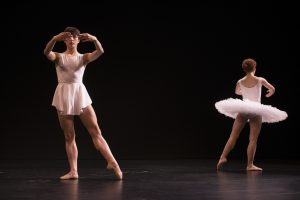
 For the first quarter hour of Heather Kravas's "a quartet", I couldn't see the four dancers' faces. This wasn't true for everyone in the audience: in fact, there were likely only about six or seven of of us in all who watched the dancers' backs. Still, it proved a fitting start to this intriguing -- and often frustrating -- piece.
For the first quarter hour of Heather Kravas's "a quartet", I couldn't see the four dancers' faces. This wasn't true for everyone in the audience: in fact, there were likely only about six or seven of of us in all who watched the dancers' backs. Still, it proved a fitting start to this intriguing -- and often frustrating -- piece.
"a quartet", which is currently at The Kitchen as part of Performance Space 122's Coil Festival, begins in strange juxtaposition: the dancers' bodies are mechanized, made into the gears of a four-part engine; and yet, they speak, over and over and over, the very human word 'want'. "Want. Want. Want, want, want, want want want wantwantwantwant want want gasp want want want..." they intone, speeding and slowing, four voices overlapping and fusing like the hum of a machine or the deep "om" chanted at the end of yoga practice. Hips piston and jut, hands hold tight to shoulders or tighten into fists; the machine speeds to the point of breaking down. And eventually, the bodies turn back into people: one at a time, they strip out of their shoes and clothes, walk to one end of the room, and lie down -- coming to rest in ever-so-slight variations of repose.
This opening is without question the work's most successful vignette. It is breathless in its virtuosity, pleasingly absurd, and not without humor. As a whole, however, "a quartet" is the sort of piece that both states too obviously what it is all about (and I mean this quite literally: the dancers use their nearly naked bodies to form the letters of "SOCIETY" on the floor) and somehow manages to become muddled along the way.
As the piece continues, the dancers change into ballet attire: one (Liz Santoro) dons a white tutu, another (Cecilia Eliceche) puts on white practice clothes. The remaining two (Oren Barnoy and Jennifer Kjos) wear the clothing of dance teachers and ballet masters. As Santoro and Eliceche do endless tendus and sous-sous, drawing towards and away from each other in ever more intricate patterns, the other two dancers, accompanied by the sounds of alarms, pace up and down the sides of the room in stern lines. What is strangest here is that none of the four really have a ballet dancer's training. Yes, Santoro and Eliceche can pull off a reasonably well turned out tendu, but it appears strained; their posture looks tense, rather than open.
Is this the aesthetic Kravas was going for? Perhaps. Certainly, she seems be insisting on the connection between the robotic machine of the first vignette and ballet's strict and unnatural regulation of the body. And the friction between the individual and the collective is central to the piece: it concludes with a folk dance-inspired section, in which the dancers begin with more individualized steps, ringing bells of different timbres, but ultimately all fall in to the same patterns. There are interesting ideas at work here, to be sure; and if the piece were to retain the intrigue of its opening, it could be fascinating.
For more on PS122's Coil Festival, check out our article here: [LinkButton]https://stagebuddy.com/events/explore-inner-performance-space-at-coil-festival/[/LinkButton]